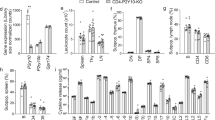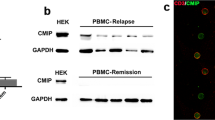Abstract
The extracellular lysophospholipase D autotaxin (ATX) and its product, lysophosphatidic acid, have diverse functions in development and cancer, but little is known about their functions in the immune system. Here we found that ATX had high expression in the high endothelial venules of lymphoid organs and was secreted. Chemokine-activated lymphocytes expressed receptors with enhanced affinity for ATX, which provides a mechanism for targeting the secreted ATX to lymphocytes undergoing recruitment. Lysophosphatidic acid induced chemokinesis in T cells. Intravenous injection of enzymatically inactive ATX attenuated the homing of T cells to lymphoid tissues, probably through competition with endogenous ATX and exertion of a dominant negative effect. Our results support the idea of a new and general step in the homing cascade in which the ectoenzyme ATX facilitates the entry of lymphocytes into lymphoid organs.
This is a preview of subscription content, access via your institution
Access options
Subscribe to this journal
Receive 12 print issues and online access
$209.00 per year
only $17.42 per issue
Buy this article
- Purchase on Springer Link
- Instant access to full article PDF
Prices may be subject to local taxes which are calculated during checkout






Similar content being viewed by others
References
Miyasaka, M. & Tanaka, T. Lymphocyte trafficking across high endothelial venules: dogmas and enigmas. Nat. Rev. Immunol. 4, 360–370 (2004).
Rosen, S.D. Ligands for L-selectin: homing, inflammation, and beyond. Annu. Rev. Immunol. 22, 129–156 (2004).
von Andrian, U.H. & Mempel, T.R. Homing and cellular traffic in lymph nodes. Nat. Rev. Immunol. 3, 867–878 (2003).
Drayton, D.L., Liao, S., Mounzer, R.H. & Ruddle, N.H. Lymphoid organ development: from ontogeny to neogenesis. Nat. Immunol. 7, 344–353 (2006).
Ley, K., Laudanna, C., Cybulsky, M. & Nourshargh, S. Getting to the site of inflammation: the leukocyte adhesion cascade updated. Nat. Rev. Immunol. 7, 678–689 (2007).
Butcher, E.C. & Picker, L.J. Lymphocyte homing and homeostasis. Science 272, 60–66 (1996).
Ley, K. Arrest chemokines. Microcirculation 10, 289–295 (2003).
Girard, J.-P. & Springer, T.A. Cloning from purified high endothelial venule cells of hevinl a close relative of the antiadhesive extracellular matrix protein SPARC. Immunity 2, 113–123 (1995).
Izawa, D. et al. Expression profile of active genes in mouse lymph node high endothelial cells. Int. Immunol. 11, 1989–1998 (1999).
Palmeri, D., Zuo, F.R., Rosen, S.D. & Hemmerich, S. Differential gene expression profile of human tonsil high endothelial cells: implications for lymphocyte trafficking. J Leuk. Biol. 75, 910–927 (2004).
Stracke, M.L. et al. Identification, purification, and partial sequence analysis of autotaxin, a novel motility-stimulating protein. J. Biol. Chem. 267, 2524–2529 (1992).
Murata, J. et al. cDNA cloning of the human tumor motility-stimulating protein, autotaxin, reveals a homology with phosphodiesterases. J. Biol. Chem. 269, 30479–30484 (1994).
Mills, G.B. & Moolenaar, W.H. The emerging role of lysophosphatidic acid in cancer. Nat. Rev. Cancer 3, 582–591 (2003).
Tanaka, M. et al. Autotaxin stabilizes blood vessels and is required for embryonic vasculature by producing lysophosphatidic acid. J. Biol. Chem. 281, 25822–25830 (2006).
van Meeteren, L.A. et al. Autotaxin, a secreted lysophospholipase D, is essential for blood vessel formation during development. Mol. Cell. Biol. 26, 5015–5022 (2006).
Lee, H.Y. et al. Stimulation of tumor cell motility linked to phosphodiesterase catalytic site of autotaxin. J. Biol. Chem. 271, 24408–24412 (1996).
Umezu-Goto, M. et al. Autotaxin has lysophospholipase D activity leading to tumor cell growth and motility by lysophosphatidic acid production. J. Cell Biol. 158, 227–233 (2002).
Tokumura, A. et al. Identification of human plasma lysophospholipase D, a lysophosphatidic acid-producing enzyme, as autotaxin, a multifunctional phosphodiesterase. J. Biol. Chem. 277, 39436–39442 (2002).
Goetzl, E.J. & Rosen, H. Regulation of immunity by lysosphingolipids and their G protein-coupled receptors. J. Clin. Invest. 114, 1531–1537 (2004).
Hama, K. et al. Lysophosphatidic acid and autotaxin stimulate cell motility of neoplastic and non-neoplastic cells through LPA1. J. Biol. Chem. 279, 17634–17639 (2004).
Cyster, J.G. Chemokines, sphingosine-1-phosphate, and cell migration in secondary lymphoid organs. Annu. Rev. Immunol. 23, 127–159 (2005).
Jansen, S. et al. Proteolytic maturation and activation of autotaxin (NPP2), a secreted metastasis-enhancing lysophospholipase D. J. Cell Sci. 118, 3081–3089 (2005).
Koike, S., Keino-Masu, K., Ohto, T. & Masu, M. The N-terminal hydrophobic sequence of autotaxin (ENPP2) functions as a signal peptide. Genes Cells 11, 133–142 (2006).
Baekkevold, E.S. et al. Culture characterization of differentiated high endothelial venule cells from human tonsils. Lab. Invest. 79, 327–336 (1999).
Cohen, D., Rodriguez-Boulan, E. & Musch, A. Par-1 promotes a hepatic mode of apical protein trafficking in MDCK cells. Proc. Natl. Acad. Sci. USA 101, 13792–13797 (2004).
Ruoslahti, E. RGD and other recognition sequences for integrins. Annu. Rev. Cell Dev. Biol. 12, 697–715 (1996).
Kitani, A. et al. Soluble VCAM-1 induces chemotaxis of Jurkat and synovial fluid T cells bearing high affinity very late antigen-4. J. Immunol. 161, 4931–4938 (1998).
Stam, J.C., Michiels, F., van der Kammen, R.A., Moolenaar, W.H. & Collard, J.G. Invasion of T-lymphoma cells: cooperation between Rho family GTPases and lysophospholipid receptor signaling. EMBO J. 17, 4066–4074 (1998).
Idzko, M. et al. Lysophosphatidic acid induces chemotaxis, oxygen radical production, CD11b up-regulation, Ca2. mobilization, and actin reorganization in human eosinophils via pertussis toxin-sensitive G proteins. J. Immunol. 172, 4480–4485 (2004).
Bleul, C.C., Fuhlbrigge, R.C., Casasnovas, J.M., Aiuti, A. & Springer, T.A. A highly efficacious lymphocyte chemoattractant, stromal cell-derived factor 1 (SDF-1). J. Exp. Med. 184, 1101–1109 (1996).
Zheng, Y., Kong, Y. & Goetzl, E.J. Lysophosphatidic acid receptor-selective effects on Jurkat T cell migration through a Matrigel model basement membrane. J. Immunol. 166, 2317–2322 (2001).
Wilkinson, P.C. The locomotor capacity of human lymphocytes and its enhancement by cell growth. Immunology 57, 281–289 (1986).
Ager, A. Regulation of lymphocyte migration into lymph nodes by high endothelial venules. Biochem. Soc. Trans. 25, 421–428 (1997).
Harris, H. The stimulation of lymphocyte motility by cultured high endothelial cells and its inhibition by pertussis toxin. Int. Immunol. 3, 535–542 (1991).
Browning, J.L. et al. Lymphotoxin-β receptor signaling is required for the homeostatic control of HEV differentiation and function. Immunity 23, 539–550 (2005).
Huber, C. et al. Lymphotoxin-β receptor-dependent genes in lymph node and follicular dendritic cell transcriptomes. J. Immunol. 174, 5526–5536 (2005).
Bayless, K.J. & Davis, G.E. Identification of dual α4β1 integrin binding sites within a 38 amino acid domain in the N-terminal thrombin fragment of human osteopontin. J. Biol. Chem. 276, 13483–13489 (2001).
Goetzl, E.J., Kong, Y. & Voice, J.K. Cutting edge: differential constitutive expression of functional receptors for lysophosphatidic acid by human blood lymphocytes. J. Immunol. 164, 4996–4999 (2000).
Rieken, S. et al. Lysophospholipids control integrin-dependent adhesion in splenic B cells through Gi and G12/G13 family G-proteins, but not through Gq/G11 . J. Biol. Chem. 281, 36985–36992 (2006).
Zheng, Y., Voice, J.K., Kong, Y. & Goetzl, E.J. Altered expression and functional profile of lysophosphatidic acid receptors in mitogen-activated human blood T lymphocytes. FASEB J. 14, 2387–2389 (2000).
Wu, H.-L. et al. Lysophosphatidic acid stimulates thrombomodulin lectin-like domain shedding in human endothelial cells. Biochem. Biophys. Res. Commun. 367, 162–168 (2008).
Miller, M.J., Wei, S.H., Parker, I. & Cahalan, M.D. Two-photon imaging of lymphocyte motility and antigen response in intact lymph node. Science 296, 1869–1873 (2002).
Bajenoff, M. et al. Highways, byways and breadcrumbs: directing lymphocyte traffic in the lymph node. Trends Immunol. 28, 346–352 (2007).
Worbs, T., Mempel, T.R., Bolter, J., von Andrian, U.H. & Forster, R. CCR7 ligands stimulate the intranodal motility of T lymphocytes in vivo. J. Exp. Med. 204, 489–495 (2007).
Okada, T. & Cyster, J.G. CC chemokine receptor 7 contributes to Gi-dependent T cell motility in the lymph node. J. Immunol. 178, 2973–2978 (2007).
Huang, J.H. et al. Requirements for T lymphocyte migration in explanted lymph nodes. J. Immunol. 178, 7747–7755 (2007).
Woolf, E. et al. Lymph node chemokines promote sustained T lymphocyte motility without triggering stable integrin adhesiveness in the absence of shear forces. Nat. Immunol. 8, 1076–1085 (2007).
Kotarsky, K. et al. Lysophosphatidic acid binds to and activates GPR92, a G protein-coupled receptor highly expressed in gastrointestinal lymphocytes. J. Pharmacol. Exp. Ther. 318, 619–628 (2006).
Lee, C.W., Rivera, R., Gardell, S., Dubin, A.E. & Chun, J. GPR92 as a new G12/13- and Gq-coupled lysophosphatidic acid receptor that increases cAMP, LPA5 . J. Biol. Chem. 281, 23589–23597 (2006).
Luster, A.D., Alon, R. & von Andrian, U.H. Immune cell migration in inflammation: present and future therapeutic targets. Nat. Immunol. 6, 1182–1190 (2005).
Fox, M.A., Collello, R.J., Macklin, W.B. & Fuss, B. Phosphodiesterase-Ialpha/autotaxin: a counteradhesive protein expressed by oligodendrocytes during onset of myelination. Mol. Cell. Neurosci. 23, 507–519 (2003).
Bistrup, A. et al. Sulfotransferases of two specificities function in the reconstitution of high-endothelial-cell ligands for L-selectin. J. Cell Biol. 145, 899–910 (1999).
Lasky, L.A. et al. An endothelial ligand for L-selectin is a novel mucin-like molecule. Cell 69, 927–938 (1992).
Acknowledgements
We thank B. Fuss (Virginia Commonwealth University Medical Center) for polyclonal anti–rat ATX; J.G. Cyster (University of California, San Francisco) for monoclonal anti–mouse α4 and anti–mouse αL and for rat insulin promoter–B lymphocyte chemokine mice; J. Bluestone (University of California, San Francisco) for nonobese diabetic mice; M. Singer and D. Tsay for assistance with homing assays; and E.J. Goetzl and J.G. Cyster for advice and critical reading of this manuscript. Supported by the National Institute of Health (RO1-GM57411 and RO1-GM23547 to S.D.R.) and the Uehara Memorial Foundation, Japan (H.K.).
Author information
Authors and Affiliations
Contributions
H.K. and S.D.R. conceptualized and designed the research and prepared the manuscript; S.D.R. supervised the research and provided intellectual guidance; H.K. did experiments and analyzed data; R.N. and R.K. participated in the early phases of this project; Y.M. quantified ATX homing; and M.D.G. supervised the in situ hybridization.
Corresponding author
Supplementary information
Supplementary Text and Figures
Supplementary Figures 1–6 (PDF 8615 kb)
Rights and permissions
About this article
Cite this article
Kanda, H., Newton, R., Klein, R. et al. Autotaxin, an ectoenzyme that produces lysophosphatidic acid, promotes the entry of lymphocytes into secondary lymphoid organs. Nat Immunol 9, 415–423 (2008). https://doi.org/10.1038/ni1573
Received:
Accepted:
Published:
Issue Date:
DOI: https://doi.org/10.1038/ni1573
This article is cited by
-
Autotaxin–lysolipid signaling suppresses a CCL11–eosinophil axis to promote pancreatic cancer progression
Nature Cancer (2024)
-
Urine autotaxin levels reflect the disease activity of sarcoidosis
Scientific Reports (2022)
-
Inhibition of lysophosphatidic acid receptor 1–3 deteriorates experimental autoimmune encephalomyelitis by inducing oxidative stress
Journal of Neuroinflammation (2021)
-
LPA signaling acts as a cell-extrinsic mechanism to initiate cilia disassembly and promote neurogenesis
Nature Communications (2021)
-
NSun2 regulates aneurysm formation by promoting autotaxin expression and T cell recruitment
Cellular and Molecular Life Sciences (2021)



